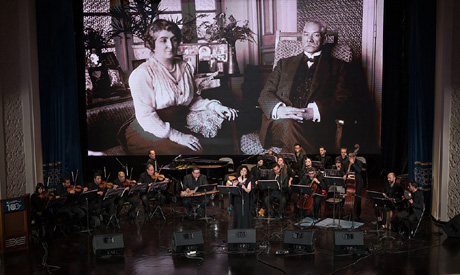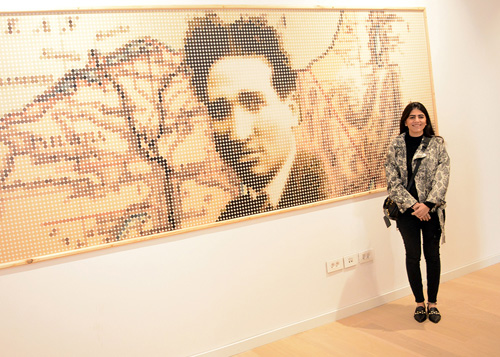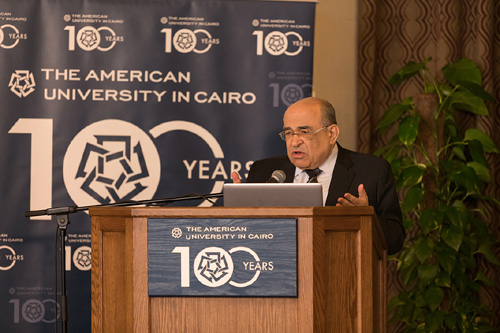
Nesma Mahgoub sings Ewart Hall
The American University in Cairo on Saturday held a celebration of Egypt’s 1919 Revolution and of composer and singer Sayed Darwish on Saturday, as part of its year-long centennial celebrations of the university.
Speakers Mostafa El Feki, director of the Bibliotheca Alexandrina, professor of gynaecology at Cairo University and political activist Mohamed Abou El-Ghar, and Sania Shaarawi, novelist and granddaughter of feminist and women’s rights activist Huda Shaarawi, discussed the eruption of the 1919 revolution, the impactful role of women, and the aftermath and the socio-economic and public forces landscape at the time in a panel at AUC’s Downtown Cairo campus.
The panel was followed by a concert showcasing a compilation of the most influential songs written for the revolution in a historic archive of lyrics, musical notations and multi-track recordings.

AUC students exhibition commemorating the 1919 Revolution
The concert featured Eskenderella, a band led by singer Hazem Shaheen, and the AUC band, with lead singer Nesma Mahgoub.
“In the modern history of Egypt, 1919 revolution is a political, social and artistic milestone. Our basic contribution was the authentication and the documentation of the art work of Sayed Darwish and the 1919 revolution. Darwish was the voice of the revolution and its magical communicating tool and we couldn’t let this milestone pass by, without at least recognising such work and great history,” Alaaeddin Edris, associate provost for research, innovation and creativity at AUC, said at a press conference on the day.
Associate professor at the Department of the Arts, who is also the director of the authentication project and the archival songs of the 1919 revolution, Wael El-Mahalawi said, “There were no written musical notations and lyrics kept changing depending on the singers so we wanted to capture the very original musical melodies and document them in proper musical notation.”
El-Mahalwai explained that many of the original records were distorted and the team worked on searching for the original lyrics to archive them. “We meant to reproduce the songs by an oriental band using music instruments similar to the ones used then. We worked on this project for six months and the recorded songs will be available on sound cloud.”

Mustafa El Feki speaks on the 1919 Revolution at AUC
#
Also on Saturday, graphic design students showcased their reflections of 1919 revolution through an exhibition that was held in Ewart Hall on the Tahrir campus.
“We are celebrating the people’s revolution, the one that can be marked without doubt in bringing Egyptians from all walks of life together. The students’ perspective towards 1919 is definitely different than that of politicians and historians. It was indeed a good way to celebrate 1919 by having students from various backgrounds analyse this event 100 years later for the first time with a fresh perspective,” said Naglaa Samir, associate professor of practice, Department of the Arts.
Samir, the curator of the exhibition, discussed how a course on packaging design evolved into an exhibition.
“We looked at ten design proposals on musical archives by students. Student Helen Bakhoum’s work was selected as the high-end design for the 100 limited edition copies. Each student presented a packaging design and 23 album art works for the songs produced.”
At the press conference, assistant director at the Rare Books and Special Collection Library Amr Kamel highlighted the role of the RBSCL in preserving the history and culture of Egypt for humanity “one document at a time. Vintage copies of the "Sphinx' magazine from 1919, photographs of Saad Zagloul, his wife's diaries as well as articles in the Musawwar about the 1919 Revolution are valuable items we are preserving. Collections like our materials documenting the 1919 Revolution can now be shared internationally thanks to new digital media that makes this an easy and effective way to collaborate in scholarly fashion."
"One of the primary pillars of the RBSCL mission is to document and conserve the historical record and artistic as well as the cultural achievements of Egypt. RBSCL accomplishes this mission by collecting primary source materials: vintage photographs, personal documents and even the oral histories of the people of Egypt."
"Today we also offer digital programmes that convert these documents into new formats to be shared online and available for Digital Humanities projects," added Kamel.

Sania Shaarawi, novelist and the granddaughter of feminist and women’s rights activist Huda Shaarawi at AUC
Short link: